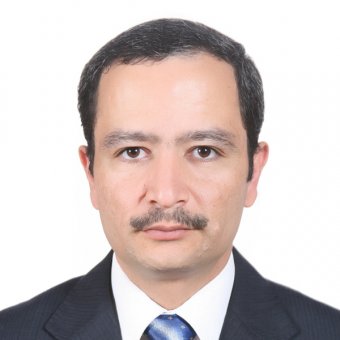
Hussam Abdel-Karim Al-Rabai'ah, Ph.D
Al Ain Campus
Education
- PhD Mathematics, University of Science, Malaysia
- MSc Mathematics, AL- al Bayt University, Jordan
- BSc Mathematics Al Yarmouk University, Jordan
Research Interests
- Ecotoxicology and its modeling
- Water quality modeling
- Environmental impact assessment
- Surface & Groundwater Flow Simulation I
- Contaminated Site Assessment
- Organic Pollutants in Marine and Terrestrial
- Environments Fate and bioaccumulation of Pollutants (Specially PCBs) in aquatic ecosystems
Selected Publications
- Study of integral type implicit multi term fractional delay differential equation with multi strip conditions
G ur Rahman, H Naz, H Alrabaiah, JF Gómez-Aguilar
Physica Scripta, 2024
S Bushnaq, A Ullah, H Alrabaiah
Partial Differential Equations in Applied Mathematics 11, 100847, 2024
- Study of 1+ 1 dimensional fractional order non-linear Benney equation using an analytical technique
I Ahmad, KJ Ansari, H Alrabaiah, D Santina, N Mlaiki
Partial Differential Equations in Applied Mathematics 11, 100823, 2024
- Dufour and Soret diffusions phenomena for the chemically reactive MHD viscous fluid flow across a stretching sheet with variable properties
SA Lone, A Khan, H Alrabaiah, S Shahab, Z Raizah, I Ali
International Journal of Heat and Fluid Flow 107, 109352, 2024
- Numerical calculation of Darcy Forchheimer radiative hybrid nanofluid flow across a curved slippery surface
H Alrabaiah, S Iftikhar, A Saeed, M Bilal, SM Eldin, AM Galal
South African Journal of Chemical Engineering 45, 172-181, 2023
- Stability and numerical analysis via non-standard finite difference scheme of a nonlinear classical and fractional order model
H Alrabaiah, RU Din, KJ Ansari, B Ozdemir
Results in Physics 49, 106536, 2023
- Coupled system of fractional impulsive problem involving power-law kernel with piecewise order
A Ali, KJ Ansari, H Alrabaiah, A Aloqaily, N Mlaiki
Fractal and Fractional 7 (6), 436, 2023
Teaching Courses
- Calculus
- Numerical Methods
- Introduction to Probability & Statistics
- Linear Algebra
Expertise related to UN Sustainable Development Goals
In 2015, UN member states agreed to 17 global Sustainable Development Goals (SDGs) to end poverty, protect the planet and ensure prosperity for all.
This person’s work contributes towards the following SDG(s):






On computation of solution for (2+1) dimensional fractional order general wave equation
Published in: Partial Differential Equations in Applied Mathematics
Oct 03, 2024
In this research article, we handle a class of (2+1) dimensional wave equations under fractional-order derivatives using an iterative integral transform due to Laplace. The concerned derivative is taken in the Caputo's sense. The proposed method is a purely algebraic manipulation approach to compute solutions without a priori knowledge of geometry and physical meaning related to the proposed problem. In fact, in this procedure, we combine two novel techniques, Laplace transforms (LT) and iterative procedures to form a hybrid technique for computation of the solution to the proposed problem. The method is rapidly convergent. Here, we give various examples for the validation of our proposed method. The superiority of the method over the existing numerical method is that it does not require any prior discretization or collocation of functions. Also, the method is independent of axillary parameters as needed in the homotopy methods, because such auxiliary parameters control the efficiency of the mentioned methods. The proposed procedure is simple and straightforward. In addition, some comparison between exact and approximate solutions is also given. The proposed method is compared with the homotopy perturbation method (HPM) which shows that the proposed technique is more efficient and easy to implement
Study of 1+1 dimensional fractional order non-linear Benney equation using an analytical technique
Published in: Partial Differential Equations in Applied Mathematics
Sep 18, 2024
The area related to fractional order partial differential equations (FOPDEs) has also attracted attention. Therefore, we focuss our attention to study nonlinear Benney equations of using power law type Caputo derivative of fractional order. To compute a series-type solution for the problem under consideration, we combine the Adomian approach with the Laplace transform. Our findings are supported by graphical representations and numerical interpretations, illustrating the applicability and insights gained from this approach in solving complex real-world problems.
A numerical investigation of the chemically reactive maxwell nanofluid flow over a convectively heated rotating disk using Darcy-Forchheimer porous medium
Published in: Modern Physics Letters B
Aug 14, 2024
This study investigates the convective heat transfer characteristics in the vicinity of a stagnation point for the flow of Maxwell nanofluid over a porous rotating disk. The analysis takes into account the complex inert-active effects arising from nonlinear thermal radiation, activation energy, and the presence of a Darcy-Forchheimer medium. Through numerical simulations, the enhancement of heat transfer due to the addition of nanoparticles is explored, considering their impact on heat transport. The rotational and porous characteristics of the disk, coupled with nonlinear thermal radiation and activation energy effects, are crucial factors in shaping the overall heat transfer behavior. The study aims to provide valuable insights into the complicated interactions of these phenomena, contributing to the understanding of advanced heat transfer processes and their potential applications in various engineering systems. Using suitable variables to convert the system of leading equations to dimensionless form has then been evaluated by employing the bvp4c approach. It has been revealed that Radial flow has retarded with an upsurge in Deborah number, inertial factor, and porous factor while has upsurge with growth in rotational factor. Angular velocity has declined with higher values of Deborah number, and porous factor and has upsurged with escalation in inertial and rotational factors. Azimuthal flow has weakened with an upsurge in porous factor and has augmented with growth in Deborah number, inertial factor, and rotational factor. Thermal profiles have augmented with an upsurge in rotational, porous, inertial, thermophoresis, Brownian, and radiation factors, and Deborah number has declined with growth in the Prandtl number. Concentration distribution has declined with an upsurge in Schmidt number, Brownian motion factor, rotation factor, and porous factor, while has grown with the escalation in chemically reactive, thermophoresis, inertial factors, and Deborah number.
Dufour and Soret diffusions phenomena for the chemically reactive MHD viscous fluid flow across a stretching sheet with variable properties
Published in: International Journal of Heat and Fluid Flow
Aug 13, 2024
The flow of fluid on a slandering stretchable sheet with variable thickness can have several engineering applications like design and optimization of, aerodynamic structures such as wings and airfoils, wind turbine blade design, efficient cooling systems for electronic devices, power plants and industrial processes. Keeping in view these important applications, this work explores Darcy-Forchheimer flow of magnetohydrodynamics (MHD) fluid across a slandering stretchable sheet with variable thickness in the presence of chemically reactive effects, and heat source. The flow is impacted by the combined influences of diffusive-thermo and thermo-diffusive phenomena. The fluid is set into motion along x-axis due to the stretching behavior of the sheet with y-axis as normal to it. Similarity transformations are employed to convert the modeled equations into nonlinear ordinary differential equations. It has observed as outcomes of this study that velocity distribution has augmented with expansion in viscosity factor and has declined with growth in permeability factor, inertia factor, and magnetic factor for both scenarios h1=0.0 and h1=0.5 where the impacts are more significant for the scenario h1=0.0. Thermal distribution has declined with augmentation in Prandtl number, permeability factor and Dufour number while has upsurge with escalation in thermal source factor for both scenarios h2=0.0 and h2=0.5. Concentration distribution has diminished with escalation in Schmidt number, chemical reactivity factor and has augmented with growth in Soret factor for both the scenarios h3=0.0 and h3=0.5 with more significant impacts in the scenario h3=0.0. Stream lines and contour lines for fluid flow have also sketched for the scenarios h1=0.0 and h1=0.5 as well as for M=0.0 and M=2.0. Validation of the proposed model and the methodology has ensured through comparison with fine agreement amongst current results and previously published work
COVID-19 Spread Modeling Incorporating Suggestive Optimal Control Strategies under Uncertainty
Published in: Advances in Systems Science and Applications
Nov 22, 2023
In the present paper, we have provided a five-compartmental epidemic model in an interval environment to analyze the spread of COVID-19 infection in India. The proposed model divides the entire population of India into five classes. They are susceptible, exposed, asymptomatic, symptomatic, and recovered classes. Under some suppositions, the crisp model is constructed and converted to an imprecise model by the interval number. We introduced a parametric functional form of an interval number to study the imprecise epidemiological model. The main objective of this study is to develop an epidemiological model in an imprecise environment and to try to understand the dynamics of the epidemic model of COVID-19 infection spread in India. We also presented the COVID-19 model with two controls to effectively control COVID-19 disease in India. Finally, a numerical simulation is carried out considering that the model parameters are imprecise. The numerical results show that our proposed imprecise model is reliable from a practical point of view.
Viscous dissipated hybrid nanoliquid flow with Darcy–Forchheimer and forced convection over a moving thin needle
Published in: AIP Advances
Sep 15, 2020
Non pharmaceutical interventions for optimal control of COVID-19
Published in: Computer Methods and Programs in Biomedicine
Sep 14, 2020
Series solutions for nonlinear time-fractional Schrödinger equations: Comparisons between conformable and Caputo derivatives
Published in: Alexandria Engineering Journal
Sep 02, 2020
Existence of fractional order semianalytical results for enzyme kinetics model
Published in: Advances in Difference Equations
Aug 11, 2020
On modeling of coronavirus-19 disease under Mittag-Leffler power law
Published in: Advances in Difference Equations
Jul 07, 2020
Fractional dynamical analysis of measles spread model under vaccination corresponding to nonsingular fractional order derivative
Published in: Advances in Difference Equations
May 14, 2020
Oscillation criteria for forced and damped nabla fractional difference equations
Published in: Journal of Computational Analysis and Applications
Jun 20, 2018
Based on the properties of Riemann–Liouville difference and sum operators, sufficient conditions are established to guarantee the oscillation of solutions for forced and damped nabla fractional difference equations. Numerical examples are presented to show the applicability of the proposed results. We finish the paper by a concluding remark.
Theories and analyses thick hyperbolic paraboloidal composite shells
Published in: American Journal of Computational Mathematics
May 13, 2015
This paper presents the stress resultants of hyperbolic paraboloidal shells using higher order shear deformation theory recently developed by Zannon [1]-[3]. The equilibrium equations of motion use Hamilton’s minimum energy principle for a simply supported cross-ply structure by Zannon (TSDTZ)[2][3]. The results are calculated for orthotropic, two-ply unsymmetrical [90/0] shells. The extensional, bending and coupling stiffness parameters are calculated using MATLAB algorithm for laminated composite hyperbolic paraboloidal shells. A comparison of the present study with other researchers in the literature is given, and is in good agreement.
Fractional-calculus diffusion equation
Published in: Nonlinear biomedical physics
Dec 17, 2010
Sequel to the work on the quantization of nonconservative systems using fractional calculus and quantization of a system with Brownian motion, which aims to consider the dissipation effects in quantum-mechanical description of microscale systems. The canonical quantization of a system represented classically by one-dimensional Fick's law, and the diffusion equation is carried out according to the Dirac method. A suitable Lagrangian, and Hamiltonian, describing the diffusive system, are constructed and the Hamiltonian is transformed to Schrodinger's equation which is solved. An application regarding implementation of the developed mathematical method to the analysis of diffusion, osmosis, which is a biological application of the diffusion process, is carried out. Schrödinger's equation is solved. The plot of the probability function represents clearly the dissipative and drift forces and hence the osmosis, which agrees totally with the macro-scale view, or the classical-version osmosis.
Fractional-calculus diffusion equation
Published in: Nonlinear biomedical physics
Dec 13, 2010
Sequel to the work on the quantization of nonconservative systems using fractional calculus and quantization of a system with Brownian motion, which aims to consider the dissipation effects in quantum-mechanical description of microscale systems. The canonical quantization of a system represented classically by one-dimensional Fick's law, and the diffusion equation is carried out according to the Dirac method. A suitable Lagrangian, and Hamiltonian, describing the diffusive system, are constructed and the Hamiltonian is transformed to Schrodinger's equation which is solved. An application regarding implementation of the developed mathematical method to the analysis of diffusion, osmosis, which is a biological application of the diffusion process, is carried out. Schrödinger's equation is solved. The plot of the probability function represents clearly the dissipative and drift forces and hence the osmosis, which agrees totally with the macro-scale view, or the classical-version osmosis.
Modeling fish community dynamics in the Florida Everglades: role of temperature variation
Published in: Water science and technology
Nov 01, 2002
Temperature variation is an important factor in Everglade wetlands ecology. A temperature fluctuation from 17°C to 32°C recorded in the Everglades may have significant impact on fish dynamics. The short life cycles of some of Everglade fishes has rendered this temperature variation to have even more impacts on the ecosystem. Fish population dynamic models, which do not explicitly consider seasonal oscillations in temperature, may fail to describe the details of such a population. Hence, a model for fish in freshwater marshes of the Florida Everglades that explicitly incorporates seasonal temperature variations is developed. The model's main objective is to assess the temporal pattern of fish population and densities through time subject to temperature variations. Fish population is divided into 2 functional groups (FGs) consisting of small fishes; each group is subdivided into 5-day age classes during their life cycles. Many governing sub-modules are set directly or indirectly to be temperature dependent. Growth, fecundity, prey availability, consumption rates and mortality are examples. Several mortality sub-modules are introduced in the model, of which starvation mortality is set to be proportional to the ratio of prey needed to prey available at that particular time step. As part of the calibration process, the model is run for 50 years to ensure that fish densities do not go to extinction, while the simulation period is about 8 years. The model shows that the temperature dependent starvation mortality is an important factor that influences fish population densities. It also shows high fish population densities at some temperature ranges when this consumption need is minimum. Several sensitivity analyses involving variations in temperature terms, food resources and water levels are conducted to ascertain the relative importance of temperature dependence terms.
Copyright © 2024 Al Ain University. All Rights Reserved.
